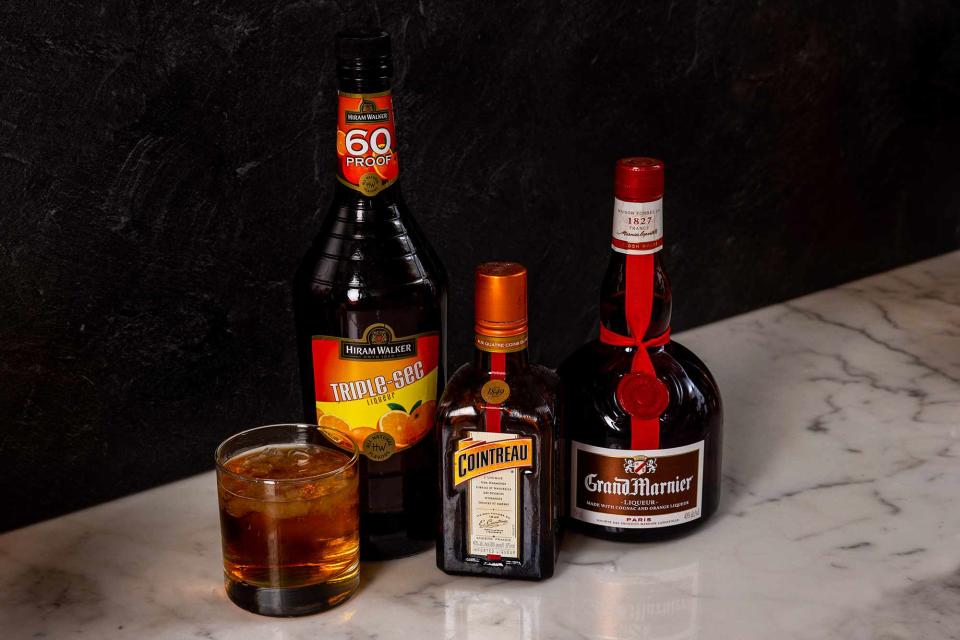Why Orange Liqueurs Should Be a Staple on Your Bar Cart
Learn how to harness the power of these classic ingredients to up your home cocktail game.

Matt Taylor-Gross
Whether or not you know what it actually is, you’ve definitely encountered Grand Marnier at some point in your life. The bell-shaped, dark amber bottle with its red moiré ribbon (or “cordon rouge”) and extra-French wax seal is altogether iconic, and a staple on bars across the world. Maybe you’ve reveled in the pleasures of a Cadillac Margarita, which is way more fun to order than a regular Margarita, or perhaps you’ve borne witness to some sort of flaming dessert, likely made possible by this Cognac-based bitter orange liqueur and its relatively high alcohol content. Either way, we’ve broken down everything you need to know about Grand Marnier and its orangey brethren so you can sound even more interesting at cocktail parties…or feel more empowered to light drinks on fire. Neither a triple sec nor a Cura?ao, here’s the lowdown on Grand Marnier and what sets it apart from its peers.
Before we dive in, let’s go back to basics — the word “liqueur” (pronounced “lee-keur”) is a French term for a category of sweetened distilled spirits that clock in anywhere between 15 and 55 percent ABV (alcohol by volume), although most liqueurs hover between 15 and 30 percent. Orange liqueurs are flavored using the orange fruit in various forms, namely the peel, which can be dried or fresh, depending on the recipe. This subcategory can further be divided into two main groups: triple secs and Cura?aos, with a few exceptions (like Grand Marnier) that lie on the fringe.
Triple Sec vs Cura?ao
So, how do triple secs and Cura?aos differ from one another? Technically, there are no laws governing either category, so the parameters around production and provenance are somewhat loose. We can generally define triple secs as clear orange-flavored liqueurs, while Cura?aos take things a step further by incorporating various herbs and spices into the mix (these can also come in a variety of colors beyond clear, such as orange or blue).
What Is Grand Marnier?
Grand Marnier is sweet but balanced, with rich notes of candied orange, toffee, caramel, hazelnut, marmalade, fresh orange zest, and of course, Cognac. While some say that Grand Marnier is a hybrid of triple sec and Cura?ao, we have to disagree. According to the brand, the makeup of Cordon Rouge (its most popular product and what most people are referring to when using the term “Grand Marnier”) is 51 percent Cognac — a protected appellation of grape brandy from France’s Cognac region — but the remaining 49 percent isn’t as much of a talking point, and like most specialty booze brands, Grand Marnier keeps the formula somewhat proprietary. But based on a variety of other sources, we can safely deduce that the non-Cognac component is a combination of distilled bitter orange essence and sugar (in other words, a liqueur). We also know that no additional herbs or spices are used, which effectively eliminates the word “Cura?ao” from the conversation.
So, in short, Grand Marnier is a blend of Cognac (slight majority) and orange liqueur. Because the orange liqueur doesn’t qualify as a Cura?ao, we can categorize that component as a triple sec.
How Is Grand Marnier Made?
Generally speaking, most orange liqueurs are made using a neutral grain or sugar beet spirit, while others use grape brandy or cane spirits, among others far less common. We can thank France for the invention of triple sec in the mid-to-late 1800s, although its creator is the subject of debate between French brands Combier and Cointreau. Furthermore, the Dutch had already been distilling orange peels for about two centuries by that point, particularly on the island of Cura?ao, where their production process used the dried peels of the local Laraha orange, along with various herbs and spices (another distinct feature separating Cura?aos from triple secs).
:
Other Cognac-Based Orange Liqueurs
In addition to Cordon Rouge, Grand Marnier also has a range of even more premium Cognac liqueurs like Cuvée du Centenaire, which uses a blend of longer-aged Cognacs (XO, or Extra Old), and Grande Cuvée Révélation, which ups the Cognac content to 91 percent as well as the minimum age of the Cognacs used in the blend to 14 years. Cointreau Noir is similar to Grand Marnier Cordon Rouge in that it includes Cognac in the blend, as does Royal Combier (specifically that of Cognac Delamain). Just like one Bordeaux or Champagne house to the next, each bottle will have its own unique taste and body.
How to Store Grand Marnier
Always make sure your liqueurs are closed properly and tightly, and in general, you’ll want to keep them in a cool, dry place. When stored properly, unopened bottles of liqueur should not go bad, but an open bottle can stay drinkable for three to six months, depending on its ingredients. Also, if you want to prevent the cap or cork of a liqueur bottle from getting sticky or stuck in place, be sure to wipe the mouth of the bottle down with a warm, wet cloth — along with the inside of the screw cap or exterior of the stopper before closing it.
Grand Marnier Cocktails
Some drink Grand Marnier neat or on the rocks as a sweet post-dinner treat. Otherwise, there’s an endless list of Grand Marnier cocktails out there.
Cadillac Margarita (a classic Margarita with a float of Grand Marnier)
A nicely balanced punch
Upgraded Pimm’s Cup
A classic Mai Tai
Again, Grand Marnier is an excellent ingredient for all kinds of baking and flambéing endeavors, but if you want to keep things simple, this liqueur is seriously delicious when drizzled over vanilla ice cream.
Although Grand Marnier is usually more expensive than triple sec, you can certainly use it in any recipe that calls for triple sec or orange liqueur (just expect a deeper, more complex flavor profile in the finished product).